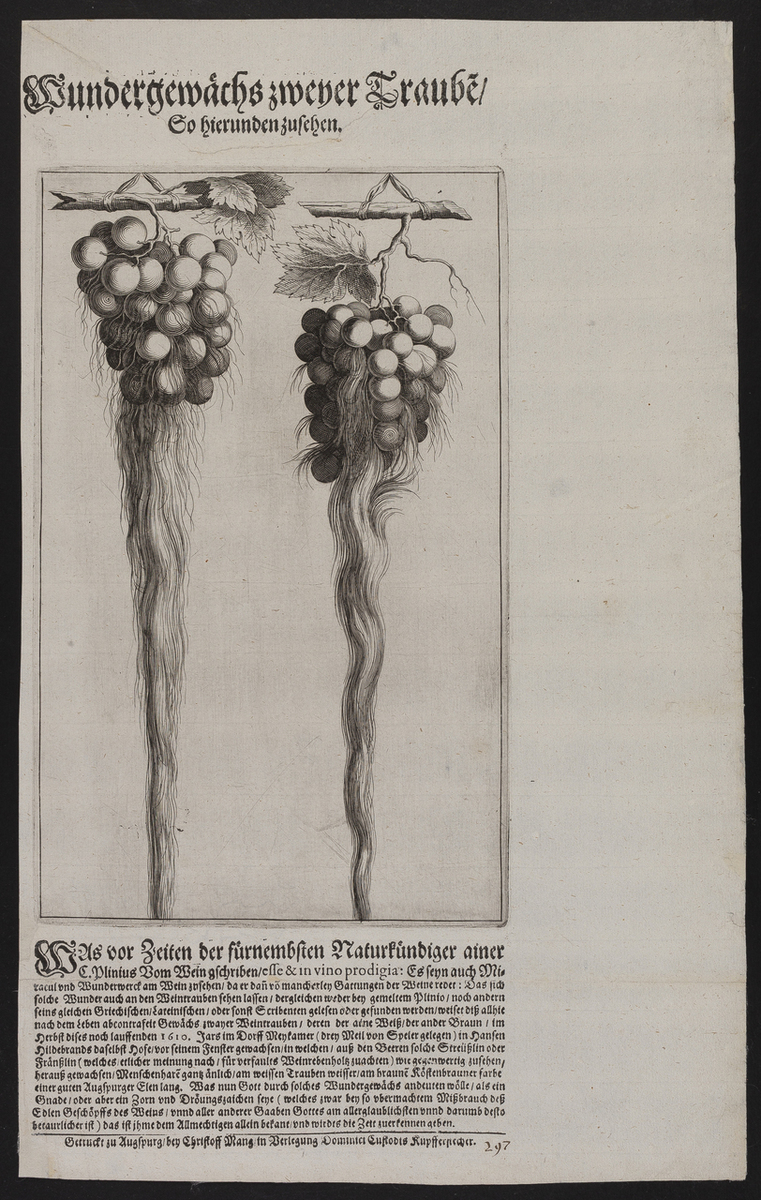A Wondrous Plant Consisting of Two Grapevines / As Seen Here (1610)
Abstract
This broadside shows so-called beard grapes, or wine grapes, which have been attacked by Cuscuta, a parasitic plant first identified in 1656. The author quotes Pliny the Elder's Naturalis historia, which actually does not mention the plant. He goes on to explain the phenomenon in terms of natural causes and informs the reader exactly when and where the grapevines were found. Eventually, he suggests that God’s anger over man’s excessive wine consumption is the likeliest explanation for this “wondrous” plant.
Source
A Wondrous Plant Consisting of two Grapevines / as seen here.
As in those times before the most esteemed naturalist, one C. Plinius [Pliny the Elder], wrote about wine / in wine there is wonder: wine is also a miracle and a wondrous sight to behold / then he speaks of many types of wines: That such wonders can also be seen in wine grapes / the likes of which were not found or described by this Pliny / or by other writers in the Greek, Latin, or other languages / is clear and visible here, in this sketch from life, showing the contrasting growth of two grapevines / one white / the other brown / in autumn of the current year of 1610. In the village of Maikammer (three miles from Speyer), in Hansen Hildebrand's farm there / before his window / where / aside from the berries, one can see little bunches or fringes (which many think / to be rotten vine wood) such as those shown here / they have sprung forth / and look quite similar to human hairs / on white grapes they are white / on the brown they are of a chestnut brown color and the length of an Augsburg cubit. What God might possibly betoken by such a wondrous plant / as a grace / or as a sign of anger and threat (which considering such overwhelming abuse of the noble creature of wine / and of all other gifts of God is most credible and therefore all the more regrettable) is known by him alone, the Almighty, and will be revealed in good time.
Translation: GHI staff

Source: Wundergewächs zweyer Traube[n]/ So hierunden zusehen. Getruckt zu Augspurg/ bey Christoff Mang in Verlegung Dominici Custodis Kupfferstecher. Broadside, 1610. Herzog August Bibliothek Wolfenbüttel.
Reproduction: Herzog August Bibliothek Wolfenbüttel
Further Reading
Deutsche illustrierte Flugblätter des 16. und 17. Jahrhunderts. Die Sammlung der Herzog-August-Bibliothek in Wolfenbüttel, Vol. 1 (Ethica, Physica), edited by Wolfgang Harms. Tübingen: Niemeyer, 1985.
Wolfgang Harms, “Der kundige Laie und das naturkundliche illustrierte Flugblatt der frühen Neuzeit,” in Berichte zur Wissenschaftsgeschichte 9 (1986), pp. 227-46.
Michaela Schwegler, »Erschröckliches Wunderzeichen« oder »natürliches Phänomenon«? Früh-neuzeitliche Wunderzeichenberichte aus der Sicht der Wissenschaft. Bayerische Schriften zur Volkskunde, Volume 7. Munich, 2002.